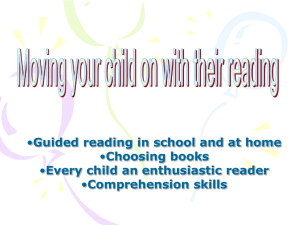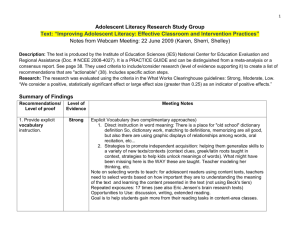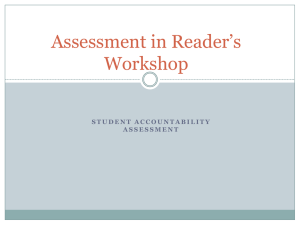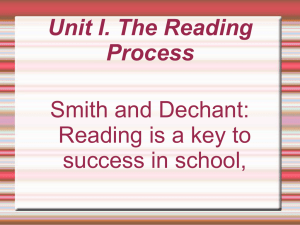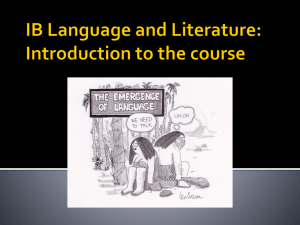Y1/2 Reading - Kings Worthy Primary School
advertisement
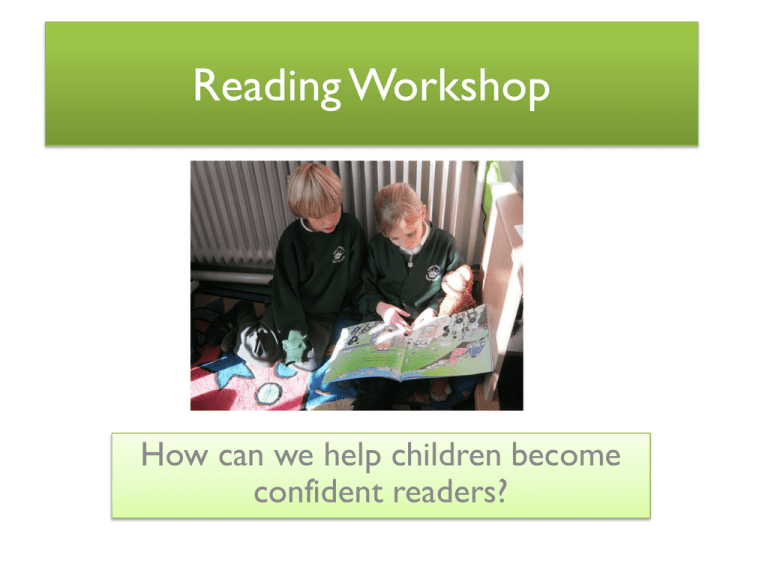
Reading Workshop How can we help children become confident readers? The ability to read is vital. It paves the way for success in school and later life. Research shows that it's the single most important thing you can do to help your child's education. There are many reasons why we read and therefore why children will read: • for pleasure and interest • for work • to learn about the world e.g. in papers • to obtain information e.g. recipes and signs Stages of Reading - 1 Pre-readers: • • • • • Look at books and like to be read to Like to behave like a reader Learn about words from songs and rhymes Learn how the text works Use pictures and memory to tell a story Stages of Reading - 2 Emerging readers: • Ready to receive instructions about reading • Know the text can be a story or information • Begin to match written words to spoken words and letters to sounds • Begin to say words in simple texts • Use the picture to understand the text Stages of Reading - 3 Early readers: • Develop more confidence • Use mainly phonic strategies to identify words • Recognise many words and are willing to try new texts • Begin to talk about the meaning of stories and texts Stages of Reading - 4 Fluent Readers: • Read for pleasure and interest with understanding • Use a variety of methods to identify words and meaning (phonic, graphic, contextual) • Read a good range of texts, making predictions and commenting on information • Relate the meaning to their own experiences and knowledge Teaching reading in school Phonic groups: • In Foundation Stage,Year One and Year Two, children are in phonic groups matched to their ability. • These sessions teach them the sounds and letter patterns which are the building blocks to reading and spelling. • It happens on a daily basis for 15 – 20mins. • It’s a very successful way to learn to read as it allows children to decode new words successfully. • It should be used as part of a language rich environment. Teaching reading in school Guided reading sessions: • A quality learning time for a small group who are at the same reading level. • The teacher identifies the next step for those children and they focus on that key skill for one or more sessions. • Between one and three times a week depending on the needs of the group. Teaching reading in school Intervention sessions: • Children whose progress is below age expectations are given daily inputs to increase their sight vocabulary. • They usually work individually with a teaching assistant on key word targets. • 10 – 15 minutes per day until they are back within age expected levels. Teaching reading in school Children also have time to practise their reading skills. • Follow up to guided sessions. • Paired reading – within the class or across classes. • Story time – children practise a text and read to the class. • Individual reading time for pleasure. How we assess children’s reading Colour banding: Children are placed on a colour band for their independent reading from Lilac for emerging readers through to Lime, Ruby and Sapphire for Fluent free readers. In their guided reading sessions they will usually be reading the colour band above as they work on their next step targets. How we assess children’s reading These colour bands are regularly reviewed through: • Formal benchmark reading tests every half term or more frequently if required. These test decoding, fluency and comprehension skills. • Informal reading assessments when sharing books with a child. How we assess children’s reading Guided reading: Children are constantly assessed during guided reading sessions using the seven Assessment Focuses (AFs) of the National Curriculum Reading Guidelines. Their next step targets will come from these AFs. How we assess children’s reading AF 1: Decoding texts AF2: Understand texts AF3: Deduce, infer or interpret information AF4: Understand the features of different texts How we assess children’s reading AF5: Explain and comment on writers’ use of language AF6: Comment on the overall effect of the text on the reader AF7: Relate texts to social, cultural and historical traditions How we assess children’s reading Statutory assessment: At the end of Key Stage One the children’s reading attainment is reported to the Local Education Authority as a National Curriculum level. A phonetic reading assessment has just been introduced into Year 1. Age expectations • Early reader by end of Foundation Stage moving into level 1 – red/yellow books • High level 1 (1a) by end of Year 1- turquoise books • Mid level 2 (2b) by end of Year 2 – gold books Reading Comprehension Reading is a balance between decoding and comprehension, both of which need teaching. As children move from being an early reader to a fluent reader their comprehension skills develop. This is extremely important; they can’t become a successful reader unless they can understand more complex texts. Talking to children about what they’re reading is vital. Reading Comprehension Many children find understanding the texts they read more difficult and need extra support. These children may be able to read all the words in a book but struggle with retrieving, deducing or inferring meaning. They need particular support before they are able to move onto harder texts. Developing Comprehension There are 3 levels of comprehension that usually develop progressively: • On the lines (the actual words – literal) • Between the lines (deduction and inference) • Beyond the lines (making comparisons and empathising) The first and most important teacher As a parent or carer you play the leading role in helping your child move through the stages of reading. The link between home and school is such an important one – children who are encouraged, supported and taught in both environments will obviously have the best chance of success. Top Tips • Read more difficult books aloud to children of all ages - it helps to keep them interested and develop their story language. • Talk about the text as much as possible - on, between and beyond the lines. • Read together – paired reading if children are less confident or read the same book as your child if they’re an independent reader so you can discuss the text. Top Tips • Make it fun – repetitive stories are great, read a wide variety of texts; stories, poems, information books, magazines, comics. • Visit the library regularly to extend their reading range. • Read every day – books, signs, newspapers, leaflets whatever you can get your hands on! What to do if you’re worried • Talk to your child’s teacher about your concerns. • They’ll discuss their strengths and weaknesses and how you can support your child. Children as readers hh

